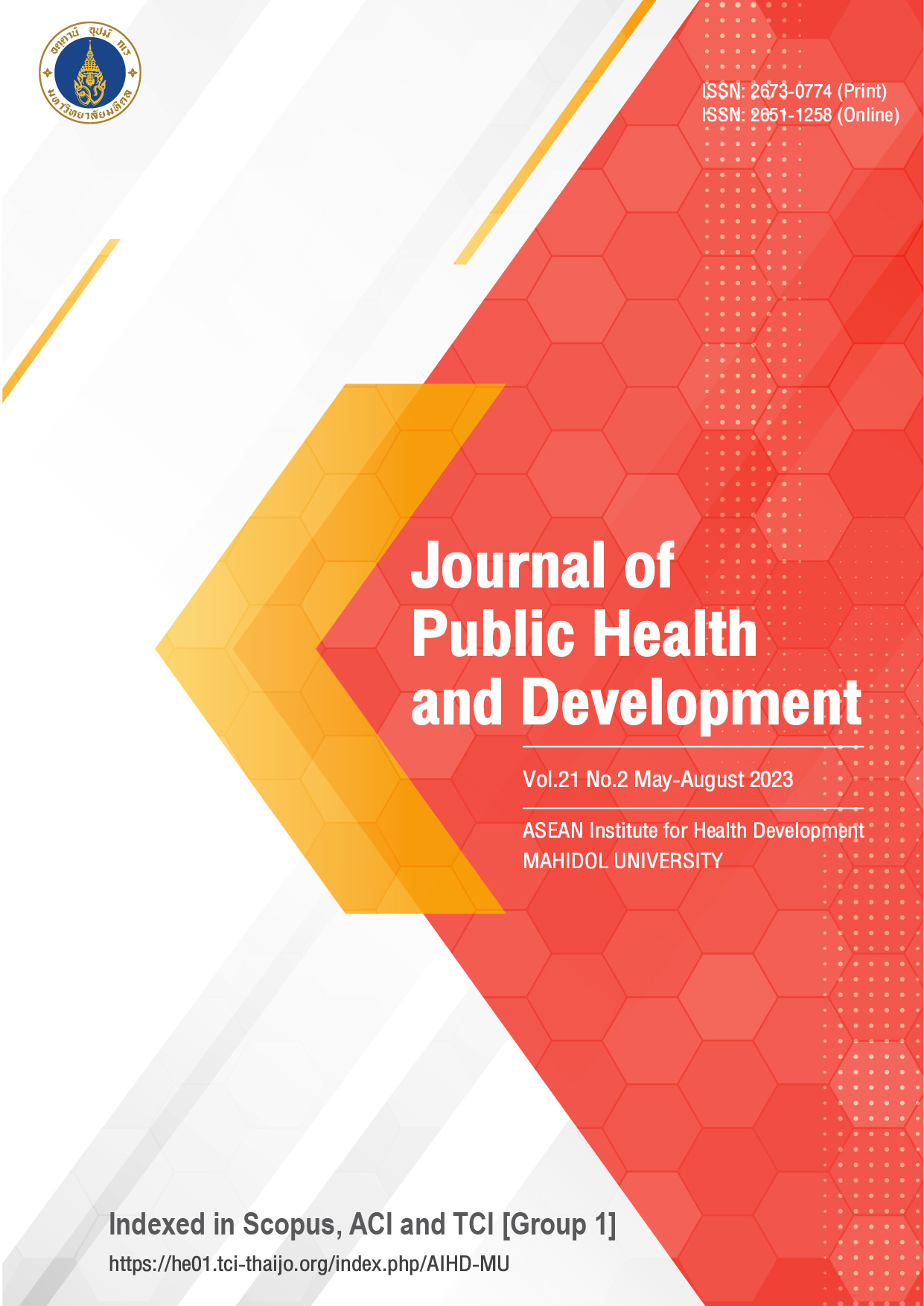Effectiveness of android-based educational media on knowledge, dietary intake and hemoglobin levels for prevention of anemia in adolescent females 10.55131/jphd/2023/210218
Main Article Content
Abstract
Compared to other media, such as print, audiovisual, and social media, educational media based on Android applications must be generated more broadly to prevent anaemia in adolescent females. This study compares the effects of e-posters and LADIES, an android-based educational media intervention, on female adolescents’ knowledge, dietary intake, and haemoglobin levels. This study was conducted using the quasi-experimental method from July to October 2022. This research utilised a pre-test-post-test and a control group design. This study’s sample comprised 49 adolescent females between the ages of 16 and 17, divided into two groups. The intervention group (n = 25) used the LADIES application media; on the other hand, the control group (n = 24) utilised the e-poster media. Results showed the average score of the knowledge (55.60 vs 91.80), nutritional intake (protein (49.41gr vs 54.38 gr), iron (6.42 mg vs 11.50 mg), and vitamin C (12.17mg vs 35.75mg)), and haemoglobin levels (12.34 mg/dl vs 13.21 mg/dl) in the LADIES group before and after the intervention and the average score of the knowledge (52.92 vs 86.46), nutritional intake (protein (50.29 gr vs 67.81 gr), iron (5.88 mg vs 8.96 mg) and vitamin C (11.49 mg vs 33.09 mg)), and haemoglobin levels (12.41 mg/dl vs 12.95 mg/dl) in the e-poster group before and after the intervention. The findings indicated that there were differences between groups in knowledge and nutritional intake (protein and iron) (p<0.01). However, there was no difference between groups in vitamin C intake (p=0.841) or hemoglobin levels (p=0.928). Education using Android-based media (LADIES) is more effective than e-poster media in enhancing female adolescents’ knowledge, nutrient intake, and haemoglobin levels.
Article Details

This work is licensed under a Creative Commons Attribution-NonCommercial-NoDerivatives 4.0 International License.
References
World Health Organization. Anaemia [Internet]. 2022. Available from: https://www.who.int/health-topics/anaemia#tab=tab_1
Kementerian Kesehatan Republik Indonesia. Laporan Riskesdas 2018 Nasional; 2019. p. 674.
Laksmita S, Yenie H. Hubungan Pengetahuan Remaja Putri Tentang Anemia dengan Kejadian Anemia di Kabupaten. J Ilm Keperawatan Sai Betik. 2018;14(1):104–7.
Singh M, Honnakamble RA, Rajoura OP. Knowledge, attitude and practice change about Anemia after intensive health education among adolescent school girls of Delhi: an intervention study. Int J Med Public Heal. 2019;9(3):71–3.
Yates-Doerr E. Reworking the Social Determinants of Health: Responding to Material-Semiotic Indeterminacy in Public Health Interventions. Med Anthropol Q. 2020;34(3):378-97. doi: 10.1111/maq.12586.
Dewi RDC, Utami CD, Cahyaningrum DG. Sosialisasi Informasi Gizi Remaja Dalam Meningkatkan Kesehatan Di Masa Pandemi Covid-19 Terkait Anemia Dan Diet Rendah Serat Di Desa Sembungan Kasihan Bantul Yogyakarta. J-Abdi J Pengabdi Kpd Masy. 2022;2(1):3763–8.
Lee W, Chae YM, Kim S, Ho SH, Choi I. Evaluation of a mobile phone-based diet game for weight control. J Telemed Telecare. 2010;16(5):270-5. doi: 10.1258/jtt.2010.090913.
Mira JJ, Navarro I, Botella F, Borrás F, Nuño-Solinís R, Orozco D, et al. A Spanish pillbox app for elderly patients taking multiple medications: randomized controlled trial. J Med Internet Res. 2014;16(4):e99. doi: 10.2196/jmir.3269.
Peiris D, Praveen D, Johnson C, Mogulluru K. Use of mHealth systems and tools for non-communicable diseases in low- and middle-income countries: a systematic review. J Cardiovasc Transl Res. 2014;7(8):677-91. doi: 10.1007/s12265-014-9581-5.
Heaney S, O'Connor H, Michael S, Gifford J, Naughton G. Nutrition knowledge in athletes: a systematic review. Int J Sport Nutr Exerc Metab. 2011;21(3):248-61. doi: 10.1123/ijsnem.21.3.248.
Kominfo. Juta Domain.id Tak Optimal. 2018.
Dahlan SM. Besar Sampel dan Cara Pengambilan Sampel. Jakarta: Salemba Medika; 2010.
Story M, Neumark-Sztainer D, French S. Individual and environmental influences on adolescent eating behaviors. J Am Diet Assoc. 2002;102(3 Suppl):S40-51.
Jalambo MO, Sharif R, Naser IA, Karim NA, others. Improvement in knowledge, attitude and practice of iron deficiency anaemia among iron-deficient female adolescents after nutritional educational intervention. Glob J Health Sci. 2017;9(7):15–23.
Noordiati EEH, Arisani G. The Effectiveness of Mobile Application as an Alternative of Health Education Media for Adolescents in the Middle School. Indian J Forensic Med Toxicol. 2020;14(3):2291–5.
Yusoff H, Daud WN, Ahmad Z. Nutrition education and knowledge, attitude and hemoglobin status of Malaysian adolescents. Southeast Asian J Trop Med Public Health. 2012;43(1):192-200.
Mulyono H, Wekke IS. Strategi Pembelajaran di Abad Digital. J Chem Inf Model. 2018;5(13):18–32.
Brown CL, Perrin EM. Obesity Prevention and Treatment in Primary Care. Acad Pediatr. 2018;18(7):736-45. doi: 10.1016/j.acap.2018.05.004.
Jaelani M, Simanjuntak BY, Yuliantini E. Faktor risiko yang berhubungan dengan kejadian anemia pada remaja putri. J Kesehat. 2017;8(3):358–68.
Silalahi V, Aritonang E, Ashar T. Potensi pendidikan gizi dalam meningkatkan asupan gizi pada remaja putri yang anemia di Kota Medan. KEMAS J Kesehat Masy. 2016;11(2):295–301.
Alaunyte I, Perry JL, Aubrey T. Nutritional knowledge and eating habits of professional rugby league players: does knowledge translate into practice? J Int Soc Sports Nutr. 2015;12:18. doi: 10.1186/s12970-015-0082-y.
Pakhri A, Chaerunnimah C, Rahmiyati R, others. Edukasi Gizi terhadap Pengetahuan dan Kebiasaan Jajan pada Siswa SMP Negeri 35 Makassar. Media Gizi Pangan. 2018;25(1):77–83.
Marfuah D, Kusudaryati DPD. The Effectiveness of Nutrition Education on Improving Iron Intake in Teenage Daughter. Profesi. 2016;14(9):5–9.
Nugroho FA, Kusumastuty I, Prihandini ZP, Cempaka AR, Ariestiningsih AD, Handayani D. Pemanfaatan Video Edukasi Dalam Perbaikan Pengetahuan Gizi Pada Remaja. Smart Soc Empower J. 2021;1(3):76–80.
Chau MM, Burgermaster M, Mamykina L. The use of social media in nutrition interventions for adolescents and young adults-A systematic review. Int J Med Inform. 2018;120:77-91. doi: 10.1016/j.ijmedinf.2018.10.001.
Zeng D, Fang ZL, Qin L, Yu AQ, Ren YB, Xue BY, et al. Evaluation for the effects of nutritional education on Chinese elite male young soccer players: The application of adjusted dietary balance index (DBI). J Exerc Sci Fit. 2020;18(1):1-6. doi: 10.1016/j.jesf.2019.08.004.
García-Casal MN, Landaeta-Jiménez M, Puche R, Leets I, Carvajal Z, Patiño E, et al. A program of nutritional education in schools reduced the prevalence of iron deficiency in students. Anemia. 2011;2011:284050. doi: 10.1155/2011/284050.


